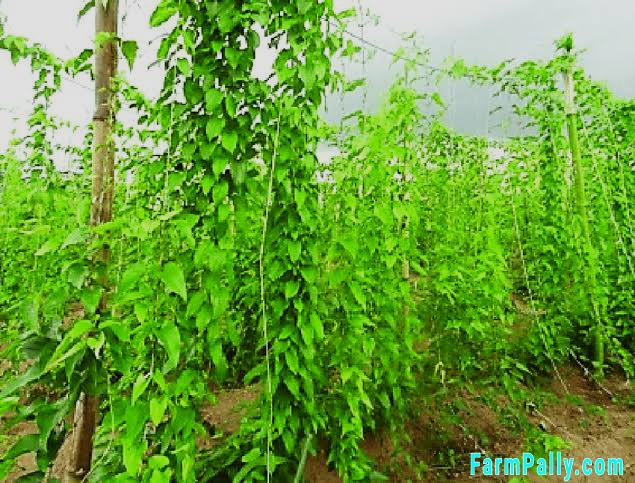Yams are grown throughout the wetter parts of the tropics. They are climbing monocotyledonous plants with opposite or alternate leaves and they produce large storage tubers.
Yams are obtained from several species of the genus Dioscorea, a very large genus with about 600 tropical or subtropical species of which only a few are grown for their stem tubers.
The growth of the crop, unlike cassava, is limited due to high labor requirements.
Origin
The species are of different origins; most are of west African and Asian origin.
Ecology
The edible yams are tropical crops that can not tolerate frost. They grow best at temperatures of 25-30°C.
A well-distributed rainfall of at least 1,500mm per annum is required.
Tuber formation is promoted by short day conditions but low light intensity or shade during the season tends to reduce yields severely.
Yams require loose, deep well-drained loam soils and grow best in good riverine soils.
Yams require reasonable soil fertility and are usually the first crops taken in the cropping cycle after the opening up of land by Farmers.
In West Africa, the northern limit of the yam zone is about 10°N, beyond which the dry season is too long.
In Nigeria, they are mainly grown in the south and middle belt and as far North as Zaria.
Botany
Yams are climbing dioecious perennial plants which are usually grown as annuals.
The fibrous root system is comparatively weak and may be spiny in some species.
They produce underground tubers, which vary greatly in number, size, and form.
The tubers consist mainly of starchy parenchyma with central vascular bundles and suberized akin.
The yam tuber is neither a stem nor a root tuber. Detailed morphogenetic studies indicate that it develops from the hypocotyl region- the transition zone between the stem and the root.
Unlike typical root tubers such as cassava, it does not develop by the enlargement of pre-formed roots and it lacks the analog of a root cap at its extreme tip.
Unlike typical stem tubers such as potatoes, it does not possess a terminal bud at their growing point, is devoid of scale leaves, and axillary buds (‘eyes’) are absent from the tuber surface.
The stems are vines, which grow up to 12m in length and are generally provided with support for climbing.
The stems may have spines or may be spineless. The long-petioled simple leaves may be opposite or alternate and are cordate or deeply lobed.
In some species, such as D. bulbifera, bulbs are produced in leaf axils. Stems climb by twining; the direction of twining is quite characteristic for species and may be clockwise or anticlockwise as in Dioscorea alata.
The flowers are small, often dioecious or unisexual; i.e. male and female flowers are borne on separate plants and male flowers are usually more numerous.
The female flowers have an inferior ovary of three carpels surmounted by three -a valved capsule or berry.
The cultivated species of Dioscorea rarely flower and the plants have been propagated for thousands of years using their tubers or stem cuttings.
Some wild species of Dioscorea contain varying amounts of a poisonous alkaloid, dioscorine in tubers.
The alkaloid is present in considerable quantities in some species, but in many of the edible types, the small amounts present are easily destroyed by boiling or roasting.
Species
The main species are:
1. Dioscorea rotundata poir. (White yam) This is the most commonly cultivated in West Africa where it originated.
It is hardy and stores well. It requires 8-10 months to mature depending on the variety.
The dormant period of the tubers permits extended storage in good condition.
The tubers are normally cylindrical with rounded or pointed ends, and smooth, brown skin white flesh, but they may assume distorted shapes.
2. D. cayenensis Lam (Yellow yam): It is a native of West Africa. It is late maturing and requires up to 12 months to reach full maturity.
The tubers produce yellow flesh and they do not store well. The tubers are large and can be harvested over a longer period.
It is not so highly regarded as the white yam but it is hardier and higher yielding.
Some authors consider D. Cayenensis and D. rotundata as belonging to the same complex, D. cayenensis- rotundata.
3. D. Alta L. (Water yam): It originated in Asia where it is widely grown. It is early maturing (7-10 months).
The tubers are variable in size, shape, and color; usually produced singly and are often very large.
The outer cortex and flesh vary from white to deep reddish purple.
Other species of lesser importance include D. esculenta (lesser yam), D. bulbifera (aerial yam), D. dumetorum (cluster yam), D. Opposita (Chinese yam), and D. trifida (cush-cush yam).
Cultural practices
In southern Nigeria, yam is planted in November while the soil is still moist (early yam) and in March-April (late yam).
In the northern parts, planting is done in may-June. Yam planted in November is usually mulched with leaves or grasses to conserve moisture during the dry season and control weeds.
The seeding rate is 2-3 t/ha of seed yam. Small tubers may be planted whole but large ones may be cut into small pieces for the economy. The top sections (with buds) of the tubers or middle sections (without buds).
Bruising of the sets should be avoided.
Planting may be in heaps or ridges. Generally, heaps are preferred in the southern parts of the country where most of the yam is staked.
The use of the heaps and stakes is rare in the northern Guinea savanna zone. In the free-draining sandy soils of Benin and eastern areas, yams may be planted in holes on the flat.
Heaps and ridges should be spaced 1.0m apart and 60cm between plants. Holes, 15cm deep, are dug at the top of the heaps or ridges.
One set is placed in each hole usually with the cut surface upward and slopping at 45 degrees.
It may be necessary to mulch with grass or leaves for yams planted before the rain started.
The major constraint in yam production is the shortage of planting materials as the edible tuber is currently used for propagation.
Recent research has shown that it is possible to propagate yams by means of true seeds, vine cuttings or minisetts.
With the minisetts technology, farmers can produce 40,000-100,000 seed yams per hectare.
Okoli et al defined a minisetts as a sett less than one quarter of the minimum size (100g) of yam sett usually planted for seed tuber production whereas commercial production of yams use 150-300g setts or more.
Minisetts from all portions of a tuber can be used and the technique has been used successfully for the three common yam species (D. rotundata, D. cayenensis and D. alata.
The minisetts are usually treated with some pesticides to protect them from soil borne pests and ensure high percentage emergence and good establishment.
Weeds can be controlled manually or with herbicides, e.g. primextra at the rate of 3kg a.i/ha, applied pre-emergence.
Fertilizers can be applied as compound NPK 15-15-15 at 300-400kg/ha. Fertilizers should be applied at 6-8 weeks in a circle or in a band, 15cm from the base of the vine, when most of the yams must have germinated and the soil is sufficiently moist.
Staking is essential for good yields. Live bush sticks are often left as stakes when clearing the bush.
Cassia, Leucaena or Gliricidia are good staking materials. In the eastern parts of Edo and Delta states, parts of Anambra and Imo States, bamboos are used.
In the derived savanna and Guinea savanna zones where stakes are not available, most yams are planted in ridges carrying maturing Guinea corn or millet.
When these cereal crops are mature, the heads are cut off and the stalks bent over and woven together to form a fence upon which the yam vines are trained.
Harvesting
Yams mature in 8-12 months, depending on the species. The early crop matures at the end of July to mid September and the main crop in mid October to January.
Two kinds of practice exist with respect to the timing of the yam harvest.
In double harvesting, each yam plant is harvested twice.
The first harvest is done at about 5-6 months. During this harvest, the tuber is carefully unearthed without damaging the plant’s roots.
The tuber is then served from the rest of the plant at a point just below the corn. The tuber is removed and the roots are covered up again with earth. The plant continues to grow and later produces a new tuber.
After the plant has finally died at the end of the season, the second harvest is done. The tuber recovered at the second harvest (seed yam) is firmer in texture and more irregular in shape than that from the first harvest.
Single harvest involves waiting until the end of the season when the vines have died, before harvesting the yams.
Yield
Under farmers’ conditions, yields of yam vary between 7-12 toms/ha. With good management, yields of up to 25 tons/ha are possible.
Harvested yams are carried to a yam barn or store where they are graded by size and quality, and tied under shade.
The tubers lose weight during storage, usually 10-15% during the first 3 months, and 30% or more after 6 months.
The major cause of lose in weight is due to respiration. The ban is the commonest form of yam storage in west Africa.
Yams are sometimes sliced and sun dried before making them into flour; they can be stored for many months in is form.
Yams can be cold stored temporarily but cold storage below 10°C results in chilling injury.
Chemical composition
The average composition of fresh yam is 60-70% water, 15-25% carbohydrates and 4-8% protein.
Uses
1. Mainly for human consumption as they provide a cheap source of carbohydrate. The most common form of yam consumption are as boiled yam, pounded yam, roasted, fried or baked yam.
2.Wild species have been used as a source material for the manufacture of oral contraceptives.
Diseases
The main diseases affecting yams are tuber rots and anthracnose.
Tuber rots are caused mostly by fungi (Penicillium spp and Fusarium spp.) and also by bacteria (Serratin spp.). The rots may infect the tuber either in the field or during storage.
Control is by treating setts with fungicide or wood ash before planting. Great care should also be taken to avoid damage to the tuners during harvest.
Anthracnose disease is particularly severe when it attacks D. alata; leaf necrosis and death of the entire plants can occur. Control is by use of resistant varieties.
Pests
The yam beetle (Heteroligus melds) is a major pest of yams in West Africa. Its eggs are laid in moist ground early in the dry season (October- November).
The larvae produced feed initially on soil humus and later on the roots of various plants in their vicinity. The larva later changes to pupa and early in the rainy season (March- June), the adult beetle emerges.
The adult flies to nearby yam plots and digs into the soil near the base of the yam plant. It continues to feed on the tuber until October or November.
The beetles then mate, migrate back to their swampy breeding ground an lay eggs there to begin another breeding cycle.
The main control for the yam beetle is to dust yam sets with insecticides, such as Aldrin and Mundane, before planting, rodents can also pose a threat to maturing tubers.
Nematodes
The yam nematode (Scutellonema bradys) and the root-knot nematode (Meloidogyne spp.) also attack yam.
These can be controlled by effective crop rotation, which include non-susceptible crops.

Growing up in a family deeply rooted in agriculture, I developed an early passion for cultivating the land, caring for animals, and exploring sustainable ways to improve farm productivity.
I’ve worked extensively across multiple areas of agriculture, food and cash crop cultivation, poultry farming, fish farming etc.
At FarmPally, I enjoy sharing practical insights drawn from real-life experiences to help farmers, pet owners, and agriculture lovers make informed, and sustainable decisions.

